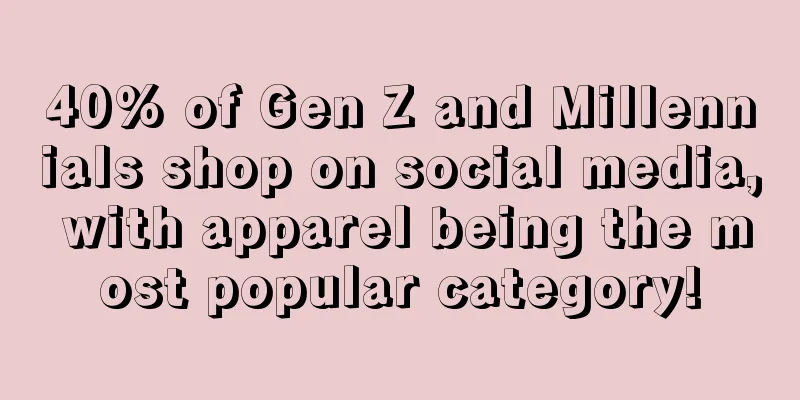40% of Gen Z and Millennials shop on social media, with apparel being the most popular category!

|
The Influencer Marketing Factory released the "Social E-Commerce Status Report" last month. Let's take a look at the development of social e-commerce! Let’s first clarify the concept of social commerce. Social commerce refers to the process of selling products directly on social media, where consumers can complete the entire shopping process from product discovery and research to checkout without leaving the platform. From the perspective of the entire market size, eMarketer predicts that total social e-commerce sales in the United States will increase by 34.8% in 2021 to US$36.09 billion, accounting for 4.3% of total US e-commerce sales. In addition, a survey conducted by eMarketer in January showed that the number of social e-commerce buyers in the United States increased by 25.2% in 2020 to 80.1 million, and is expected to increase by another 12.9% to 90.4 million by 2021. The Influencer Marketing Factory’s study of 350 American Gen Z and Millennials found that almost half ( 40%) of Gen Z and Millennials have purchased products they had previously seen on social media apps or live broadcasts . 60% of Gen Z and Millennials have purchased something after seeing content posted by an influencer , and 46% of Gen Z and Millennials say they make at least one purchase on social media per month . Despite the convenience of shopping on social apps , Generation Z likes to save specific items first and research brands and products before purchasing them. About 53% of respondents said they like to carefully research the products they buy online before buying . Additionally, approximately 61% said they prefer the “add to cart” option for shopping on social media , while 39% still prefer redirecting to a third-party website. Apparel ( 41%) leads the pack when it comes to the top items purchased on social channels , followed closely by beauty products ( 23%), followed by technology and home products.
It is worth noting that the younger generation prefers online shopping . Sellers should also pay more attention to the younger generation's social media usage preferences and consumption needs, such as their preference to interact with brands. In summary, major social media platforms are actively promoting the development of e-commerce. The development prospects of social e-commerce are still relatively promising, and sellers can also pay more attention to this area. Social e-commerce Generation Z Millennials |
<<: Indonesian platform Blibli holds Ramadan shopping festival, offers two-hour delivery service
Recommend
Delta virus spreads in the US, Amazon postpones employees' return to work until 2022
Amazon has told its U.S. corporate employees not ...
Temu sweeps the US market, and established giants face challenges
As a rising star in the cross-border e-commerce p...
Orders are scheduled until the second half of the year! Anker has already laid out its strategy for this market
The global spread of the COVID-19 pandemic has ob...
Temu is sued again! Facing the third class action lawsuit
Temu has gained a lot of popularity in North Amer...
What is Kenya Capital Markets Authority (CMA)? Kenya Capital Markets Authority (CMA) Review, Features
<span data-docs-delta="[[20,{"gallery"...
What is Deshang International Freight? Deshang International Freight Review, Features
Shenzhen Deshang International Freight Forwarding ...
Indian e-commerce company Udaan seizes new business opportunities and sells 160 million electronic products a year!
Udaan , India's largest B2B e-commerce platfo...
Amazon is hit by an antitrust lawsuit, and FBA is the focus of attention!
Recently, the U.S. Federal Trade Commission ( FTC...
What is AppsFlyer? AppsFlyer Review, Features
AppsFlyer is a mobile attribution and marketing a...
Popular TikTok products banned by Amazon
The once popular product was once all the rage on...
Repeatedly on Amazon's BS list! Outdoor sales made $420 million in three months
On the Amazon platform, a brand that started out ...
The best sellers on the niche platform soared, earning 570 million yuan in two and a half years
Not long ago, when many sellers were browsing the...
The last four hours of sprint! Tmall Double 11 discounts will be increased. If you miss it, you will have to wait for a year.
There are still 4 hours left before the end of Tm...
Hot sale: 500,000 units sold in one year! Outdoor sellers are popular in Europe and America
There has been a recent upsurge in outdoor campin...
160,000 units sold! The epidemic has boosted sales of color home appliances in South Korea
As the epidemic spreads for a long time, people s...









